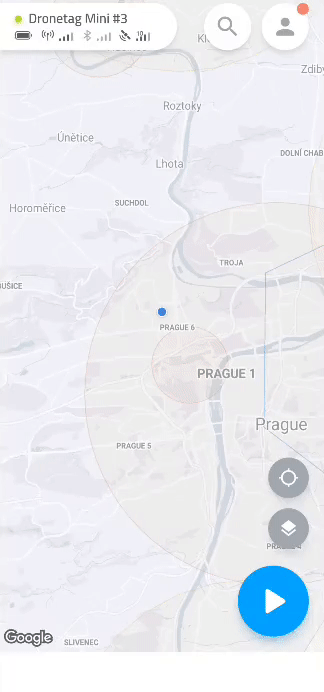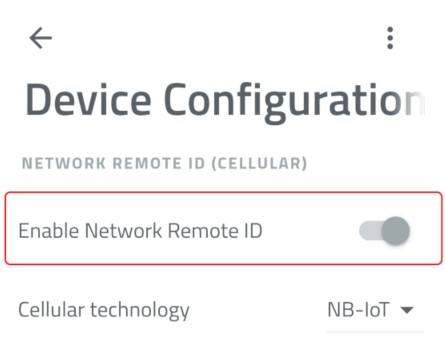Configuration
The Mini is a highly customizable piece of hardware to suit your flight's needs. It allows you to configure various device parameters, which will help you optimize the performance and battery usage. Configuration is manageable in the Mobile app via Bluetooth.

General
- Flight auto-start is an option (enabled by default) that automatically initiates the flight when the device is ready for the flight (has GNSS fix and NRI/DRI is set). If you disable this option, a short button press in Flight Ready state is needed to start the flight manually.
- MAVlink flight control is an option (disabled by default) that takes care of starting/ending your flight based on the data sent on MAVlink protocol when EXT port is connected to MAVlink flight controller.
- Button flight control is an option (enabled by default) that controls whether Dronetag Mini button can be used for starting/ending the flight. Disable this option only if you think the button can be accidentally pressed by something inside the drone while it is in flight.
- USB Mode (disabled by default) ensures that the device operates in tandem with the drone's activation. It's crucial to enable this mode only when planning to connect the Beacon directly to your drone and utilize the drone's power source to operate it. Activating USB Mode may affect the Beacon's ability to undergo firmware updates while not connected to USB.
- LED Brightness adjusts the brightness level of the LED indicators.
- Auto Power Off interval defines the idle time (in minutes) after which the device will automatically shut down.
Flights
- Store flight data is an option (disabled by default) that automatically stores all flight data, such as duration, path and altitude directly on the device. The device has limited storage, so you should donwload your flight data regularly.
Network Remote ID
Network Remote ID broadcast service is enabled by default. If you want to turn this option off, navigate to Network Remote ID in Device Configuration and switch off the toggle, save the settings and restart the device.
This is necessary step in case you decide to use Free subscription plan



- Telemetry aggregation coefficient specifies how many telemetries are aggregated into a single message before sending it to the cloud. Therefore, it also determines how often are telemetry messages sent. E.g. if your GNSS update rate is set for 4 Hz and your aggregation coeff. has a value of 4, you will transmit telemetry each second containing four different telemetries. The recommended value is 1 with a 1 Hz GNSS update rate equivalent to one sent telemetry every second.
Direct Remote ID
- Static data frequency configures the frequency of the DRI messages containing takeoff location, UAS Operator ID, and Aircraft ID.
- Dynamic data frequency configures the frequency of the DRI messages with telemetry data.
Sensors
- GNSS input configures which GNSS receiver is used as an input for sending the NRI and DRI. Possible options are Internal for Dronetag Mini receiver, MAVlink for reading the data from MAVlink flight controller through EXT port, and Simulated for artificial simulated data for debugging/troubleshooting/testing purpose. Simulated must not be used for general usage.
- Internal GNSS mode configures the mode of internal GNSS receiver. The Full power mode has about five times higher power consumption than the Power-saving mode. Therefore, it is recommended to use Full power mode only in challenging conditions where problems with GNSS fix occur.
- Location update rate configures the update and navigation rate of the GNSS receiver in Hz. A higher value means more up-to-date data for DRI/NRI but consumes more power. Thus 1 Hz is recommended for general use.
Device Inputs & Outputs
- External LTE antenna allows selecting internal or optional external LTE antenna.
- External Bluetooth antenna allows selecting internal or optional external Bluetooth antenna.
Cellular Connectivity
Settings in this section are country-specific and you shouldn’t change the values unless you know what you are doing. If you change the country, please tap on Configure network automatically and turn the device off and on to find the new cellular settings.
For more information about Dronetag cellular coverage and possible settings, visit this page. Contact the Dronetag team if you are unsure about your settings.